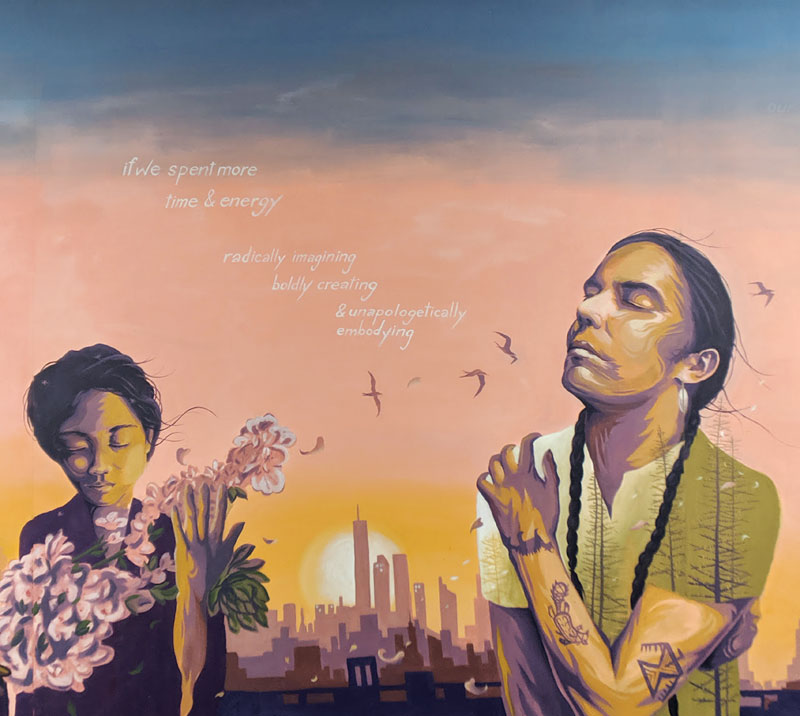
This article is from the Fall 2021 issue of the Nonprofit Quarterly.
Human evolution has been about getting more out of life, or increasing life—span, health, and joy.1 But, we have reached a point of unsustainability, when there is more life being taken out of systems than is being put in, and so many are in collapse, and anxiety is the norm.2 In order to reverse this trend and continue to have life, we must mount the biggest, deepest social justice movement ever—a global climate justice movement.
Social movements tend to develop the collective vision for the work, so a good place to start this exploration is to look at what climate justice movement leaders are saying is necessary, and if that gets us closer to the life-giving systems and practices we need now.
THE GREEN NEW DEAL
House Resolution 109, or the Green New Deal, is a U.S. congressional resolution to “mobilize every aspect of American society to 100% clean and renewable energy, guarantee living-wage jobs for anyone who needs one, and a just transition for both workers and frontline communities—all in the next 10 years.”3
The idea of a Green New Deal emerged during the 2007–2008 financial crisis in both the United States and United Kingdom. The United Kingdom–based Green New Deal Group published the first report laying out its key elements: “reining in the power of big finance and transforming the way that government manages the economy with a plan to transform the economy and society to meet the challenges of climate change.”4
The idea was reintroduced in 2018 by U.S. Representative Alexandria Ocasio-Cortez and the Sunrise Movement, “a movement of young people to stop climate change and create millions of jobs in the process.”5 Director of Climate Policy at the Roosevelt Institute Rhiana Gunn-Wright, one of the primary authors, a young Black woman, told Teen Vogue that when she started working on the Green New Deal, she “had no idea it was going to turn into what it did”—something that gave young people hope.6
Gunn-Wright elucidates intersectionality when she describes how COVID put a fine point on how the movement sees the problem:
I remember looking at the map of COVID hot spots in that first wave and being like, all those are environmental justice hot spots. Those are places with disproportionate levels of air pollution and, honestly, all types of pollution in Black and brown and Indigenous communities. Then when something like a pandemic happens, the people that you need to be essential workers to keep the economy going are the same people that you have made incredibly vulnerable to all sorts of health challenges because of environmental injustice.7
Representative Ocasio-Cortez and Senator Edward Markey published the Green New Deal bill in February 2019. However, while the Green New Deal acknowledges that environmental destruction “exacerbated systemic racial, regional, social, environmental, and economic injustices” and calls on the government to “promote justice and equity,”8 it is largely an economic document focused on decarbonization.
In August 2020, Representative Ocasio-Cortez, alongside then-Senator Kamala Harris, introduced the Climate Equity Act to ensure that climate policy addresses the specific needs of “communities that have experienced environmental injustice or are vulnerable to climate injustice.”9 The bill established a Climate and Environmental Equity Office within the Congressional Budget Office, which is charged with preparing an analysis for each bill or resolution addressing environmental or climate change that includes the bill’s impacts on frontline communities.
The bill also established an Office of Climate and Environmental Justice Accountability within the Office of Management and Budget to: (1) “measure the direct and indirect costs of environmental and climate regulations on frontline communities,” (2) review agencies’ investments to determine if they “have an environmental or climate change nexus” and ensure that “frontline communities benefit from the investment,” and (3) “represent the views of frontline communities in rulemaking.”10
THE RED BLACK AND GREEN NEW DEAL
Meanwhile, the Movement for Black Lives has been highlighting how many of the issues facing Black people and communities are climate justice issues—that is, issues at the intersection of the climate crisis and growing systemic racial inequities. This year, it launched the Red Black and Green New Deal (RBG New Deal)11—a multiyear, multi-issue initiative to organize Black people to take action on mitigating the impact of the climate on Black lives.
Its national mandate reads like a Black manifesto:
At The Movement for Black Lives, we believe all Black people have the right to determine our own futures; where we can earn a decent living, purchase a home, raise a family and live in a safe community with access to reliable, clean and affordable services. We should be able to add our voice to the problems and solutions that impact our family and our community’s well being. We should be able to build a future around the things that are important to us, leaving a legacy of generational and cultural value for those that come after us.12
Its Vision for Black Lives—“a comprehensive and visionary policy agenda for the post-Ferguson Black liberation movement”—is endorsed “by over 50 Black-led organizations in the M4BL ecosystem and hundreds of allied organizations and individuals.”13 Its goals are achieved by the various campaigns it inspires across the country.
Its various policies align around six planks:
Sign up for our free newsletters
Subscribe to NPQ's newsletters to have our top stories delivered directly to your inbox.
By signing up, you agree to our privacy policy and terms of use, and to receive messages from NPQ and our partners.
- End the war on Black people
- Political power
- Community control
- Economic justice
- Divest/Invest
- Reparations
Each plank has its own set of policies that focus on the needs of those most impacted. For example, the plank “End the war on Black people” includes policies focusing on youth; women; trans, queer, gender nonconforming, and intersex people; disabled people; and migrants.14
The RBG New Deal Agenda “puts Black liberation at the center of the global climate struggle, and addresses the impacts of climate change and environmental racism on Black communities.”15
THE RED DEAL
Many young activists were inspired to fight for climate justice by their experiences at the Standing Rock resistance camp in 2016, including Representative Alexandria Ocasio-Cortez.16 Writing for The Guardian, Rebecca Solnit notes that young climate activists reported “encountering young Native people whose experiences at the protest site had encouraged them to dream of new possibilities and take actions that might otherwise have seemed out of reach.”17
The Indigenous movement that has grown out of these frontline battles has coalesced into The Red Nation, an organization “dedicated to the liberation of Native peoples from capitalism and colonialism,” who have authored the Red Deal.18
The Red Deal adds something very critical to the climate justice agenda—it moves decolonization from the margins to the center.
It focuses on, as Nick Estes, one of the cofounders of The Red Nation, writes, “creating just relations between human and nonhuman worlds on a planet thoroughly devastated by capitalism.” It seeks nothing less than “the radical transformation of all social relations between humans and earth.”19
The Red Deal also centers the justice owed to Indigenous peoples by focusing on Indigenous treaty rights, land restoration, sovereignty, self-determination, decolonization, and liberation. Its demand for a moratorium on all new fossil fuel extraction is central to both climate justice and Indigenous peoples’ justice.
And, importantly, the Red Deal centers Indigenous peoples as leaders of climate justice. “While making up only 5 percent of the world’s population, Indigenous peoples also protect 80 percent of the planet’s biodiversity.”20 And they have been criminalized in the process, which is why decriminalization of Indigenous caretakers is seen as a fundamental priority in the battle to save the planet.
Understanding firsthand the violence that follows any challenge to the fossil fuel industry, the Red Deal calls for an immediate and long-term mass social revolution that moves beyond the economic sphere to the cultural.
Further, this mass movement needs to understand and prepare for the potential violation of any new deals. Native peoples know firsthand our government’s history of violating deals, or treaties.
This deep, long-term, mass movement requires “a revolution of values that re-centers relationships to one another and earth over profits.”21 For Indigenous peoples, a new, green economy is a caretaking economy.
⬛
Climate justice has the potential to unify all other calls for justice, but only if we recognize this and mobilize around it. Prioritizing projects that enact these visions may be helped by understanding where we are in the cycle of social change. In Assembly, social change theorists Michael Hardt and Antonio Negri write:
The political division of labor within revolutionary and liberation movements between leaders and followers, strategy and tactics, rests on an appraisal of the capacities of the different actors. Only the few, the thinking goes, have the intelligence, knowledge, and vision needed for strategic planning and therefore vertical, centralized decision-making structures are required. What if we were able to verify, instead, that capacities for strategies are today becoming more generalized? What if democratic, horizontal social movements were developing the ability to grasp the entire social field and craft lasting political projects? … [R]ecognizing today’s changing social capacities allows us to reverse the polarity of the dynamic, and that shift could have extraordinary effects. Our first call is thus to invert the roles: strategy to the movements and tactics to the leadership.22
These movements are indeed taking the lead on strategy, and offering visions of a living world based in relationships of care.
Notes
- Thomas Troward, The Creative Process in the Individual (Camarillo, CA: DeVorss Publications, 1991; orig. 1915), 3.
- Tony Fry, Design as Politics (Oxford, UK: Berg, 2011), 21.
- “What is the Green New Deal?,” Sunrise Movement, accessed September 30, 2021.
- “History of the Green New Deal,” the Green New Deal Group; and see A Green New Deal: Joined-up policies to solve the triple crunch of the credit crisis, climate change and high oil prices (Green New Deal Group, July 2008).
- “Donate today to help Sunrise win a Green New Deal.,” Sunrise Movement, accessed September 30, 2021.
- Jacqui Germain, “What Is Climate Justice? A Framework for Understanding the World,” Teen Vogue, June 4, 2021.
- Ibid.; and Katherine Bagley, “Connecting the Dots Between Environmental Injustice and the Coronavirus,” Yale Environment 360, May 7, 2020.
- Recognizing the duty of the Federal Government to create a Green New Deal, H.Res.109 — 116th Congress (2019-2020), 4, 6.
- Climate Equity Act of 2020, Summary: H.R.8019 — 116th Congress (2019-2020).
- Ibid., 9, 43, 42, 9.
- “A National Black Climate Mandate,” M4BL, Red Black & Green New Deal, accessed September 30, 2021; and Red, Black, and Green New Deal: A National Black Climate Agenda, M4BL, The Action Network, n.d.
- “The Red Black And Green New Deal (RBGND): Climate Justice is Racial Justice,” M4BL, Red Black & Green New Deal, accessed September 30, 2021.
- “Vision for Black Lives,” M4BL, Red Black & Green New Deal, accessed September 30, 2021.
- Ibid.
- Red, Black, and Green New Deal: A National Black Climate Agenda, 2.
- Charlotte Alter, “‘Change Is Closer Than We Think.’ Inside Alexandria Ocasio-Cortez’s Unlikely Rise,” Time, March 21, 2019.
- Rebecca Solnit, “Standing Rock inspired Ocasio-Cortez to run. That’s the power of protest,” The Guardian, January 14, 2019.
- The Red Deal: Indigenous Action to Save Our Earth, Part One: End the Occupation, The Red Nation, n.d.
- Nick Estes, “A Red Deal,” Jacobin, accessed September 30, 2021.
- Ibid.
- Ibid.
- Michael Hardt and Antonio Negri, Assembly (Heretical Thought) (New York: Oxford University Press, 2017).











